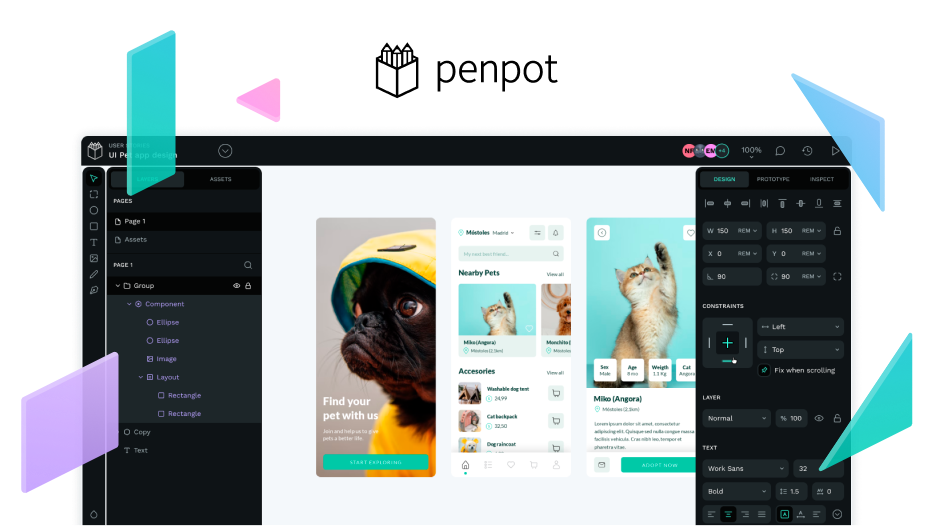I am just using the default docker-compose.yaml, except I am using folders within the directory for assets and postgres instead of pure docker volumes. For example:
volumes:
- ./postgres:/var/lib/postgresql/data
I am able to register and use the tool, but if I either tear down my docker and bring it back up or even just log out and try logging back in, I fail to authenticate.
I’m just trying to host on a local network right now, so I don’t care about auth nor mail nor security right now
.
Here is the exact yaml file (I removed some of the comments; it is just the default though):
## You can read more about all available flags and other
## environment variables here:
## https://help.penpot.app/technical-guide/configuration/#advanced-configuration
#
# WARNING: if you're exposing Penpot to the internet, you should remove the flags
# 'disable-secure-session-cookies' and 'disable-email-verification'
x-flags: &penpot-flags
PENPOT_FLAGS: disable-email-verification enable-smtp enable-prepl-server disable-secure-session-cookies
x-uri: &penpot-public-uri
PENPOT_PUBLIC_URI: http://localhost:9001
x-body-size: &penpot-http-body-size
# Max body size (30MiB); Used for plain requests, should never be
# greater than multi-part size
PENPOT_HTTP_SERVER_MAX_BODY_SIZE: 31457280
# Max multipart body size (350MiB)
PENPOT_HTTP_SERVER_MAX_MULTIPART_BODY_SIZE: 367001600
networks:
penpot:
volumes:
penpot_postgres_v15:
penpot_assets:
services:
penpot-frontend:
image: "penpotapp/frontend:${PENPOT_VERSION:-latest}"
restart: always
ports:
- 9001:8080
volumes:
- ./assets:/opt/data/assets
depends_on:
- penpot-backend
- penpot-exporter
networks:
- penpot
environment:
<< : [*penpot-flags, *penpot-http-body-size]
penpot-backend:
image: "penpotapp/backend:${PENPOT_VERSION:-latest}"
restart: always
volumes:
- ./assets:/opt/data/assets
depends_on:
penpot-postgres:
condition: service_healthy
penpot-redis:
condition: service_healthy
networks:
- penpot
## Configuration envronment variables for the backend container.
environment:
<< : [*penpot-flags, *penpot-public-uri, *penpot-http-body-size]
## Database connection parameters. Don't touch them unless you are using custom
## postgresql connection parameters.
PENPOT_DATABASE_URI: postgresql://penpot-postgres/penpot
PENPOT_DATABASE_USERNAME: penpot
PENPOT_DATABASE_PASSWORD: penpot
## Redis is used for the websockets notifications. Don't touch unless the redis
## container has different parameters or different name.
PENPOT_REDIS_URI: redis://penpot-redis/0
## Default configuration for assets storage: using filesystem based with all files
## stored in a docker volume.
PENPOT_ASSETS_STORAGE_BACKEND: assets-fs
PENPOT_STORAGE_ASSETS_FS_DIRECTORY: /opt/data/assets
## Also can be configured to to use a S3 compatible storage
## service like MiniIO. Look below for minio service setup.
# AWS_ACCESS_KEY_ID: <KEY_ID>
# AWS_SECRET_ACCESS_KEY: <ACCESS_KEY>
# PENPOT_ASSETS_STORAGE_BACKEND: assets-s3
# PENPOT_STORAGE_ASSETS_S3_ENDPOINT: http://penpot-minio:9000
# PENPOT_STORAGE_ASSETS_S3_BUCKET: <BUKET_NAME>
## Telemetry. When enabled, a periodical process will send anonymous data about this
## instance. Telemetry data will enable us to learn how the application is used,
## based on real scenarios. If you want to help us, please leave it enabled. You can
## audit what data we send with the code available on github.
PENPOT_TELEMETRY_ENABLED: true
PENPOT_TELEMETRY_REFERER: compose
## Example SMTP/Email configuration. By default, emails are sent to the mailcatch
## service, but for production usage it is recommended to setup a real SMTP
## provider. Emails are used to confirm user registrations & invitations. Look below
## how the mailcatch service is configured.
PENPOT_SMTP_DEFAULT_FROM: no-reply@example.com
PENPOT_SMTP_DEFAULT_REPLY_TO: no-reply@example.com
PENPOT_SMTP_HOST: penpot-mailcatch
PENPOT_SMTP_PORT: 1025
PENPOT_SMTP_USERNAME:
PENPOT_SMTP_PASSWORD:
PENPOT_SMTP_TLS: false
PENPOT_SMTP_SSL: false
penpot-exporter:
image: "penpotapp/exporter:${PENPOT_VERSION:-latest}"
restart: always
depends_on:
penpot-redis:
condition: service_healthy
networks:
- penpot
environment:
# Don't touch it; this uses an internal docker network to
# communicate with the frontend.
PENPOT_PUBLIC_URI: http://penpot-frontend:8080
## Redis is used for the websockets notifications.
PENPOT_REDIS_URI: redis://penpot-redis/0
penpot-postgres:
image: "postgres:15"
restart: always
stop_signal: SIGINT
healthcheck:
test: ["CMD-SHELL", "pg_isready -U penpot"]
interval: 2s
timeout: 10s
retries: 5
start_period: 2s
volumes:
- ./postgres:/var/lib/postgresql/data
networks:
- penpot
environment:
- POSTGRES_INITDB_ARGS=--data-checksums
- POSTGRES_DB=penpot
- POSTGRES_USER=penpot
- POSTGRES_PASSWORD=penpot
penpot-redis:
image: redis:7.2
restart: always
healthcheck:
test: ["CMD-SHELL", "redis-cli ping | grep PONG"]
interval: 1s
timeout: 3s
retries: 5
start_period: 3s
networks:
- penpot
## A mailcatch service, used as temporal SMTP server. You can access via HTTP to the
## port 1080 for read all emails the penpot platform has sent. Should be only used as a
## temporal solution while no real SMTP provider is configured.
penpot-mailcatch:
image: sj26/mailcatcher:latest
restart: always
expose:
- '1025'
ports:
- "1080:1080"
networks:
- penpot

